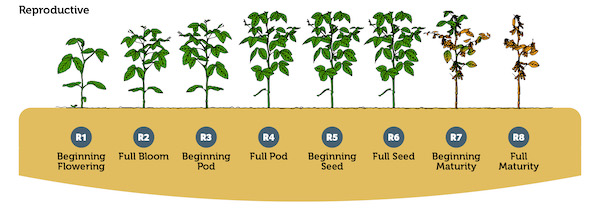As drought conditions continue to hang on in key US growing regions, crop prospects are of course a worry. Similar to corn, soybeans are at varying degrees of risk from drought and extreme heat depending on the growing stage. The major drought impact on yield potential occurs during pod set and pod fill, but drought and high soil temps may also impact soybean yield at earlier growth stages. Below are specifics about the different drought and heat threats during the critical stages:
Germination and Early Growth: Nearly all US soybean fields have now emerged. However, some late-planted beans in severe drought areas did have trouble getting out of the ground and many of those fields may be a total loss. Soybean seeds need to absorb 50% of their weight in water to initiate the germination process. Therefore, drought conditions or uneven moisture levels in the seedbed can impact final stand. Water stress can impact hypocotyl elongation as early as 2 days after germination. In many cases, dry soils are also hot soils, which can actually cause an injury called “heat canker.” Soybean seedlings that are emerging and seedlings up to the V2 growth stage are at risk for this injury. The hypocotyl cannot tolerate high temperatures and when it comes into contact with the soil it can be killed. The hypocotyl may exhibit a ring or spot that will turn dark and look sunken or pinched. This injury is usually fatal to the seedling. Normally, this injury is sporadic across the field.
Nodulation: Nodulation, the infection of the roots by nitrogen-fixing rhizobia bacteria, can be reduced under drought conditions, particularly when accompanied by high soil temperatures. Nodulation begins shortly after emergence and continues to increase until R5. Under mild drought conditions nodulation is unaffected. However, under severe drought conditions nodules can be reduced. High temperatures appear to be more detrimental to nodulation than water deficit. High soil temperature (86° F and above) can reduce nodulation by directly killing rhizobia and altering the root hair growth and absorption of the rhizobia.
Vegetative Stages: Soybeans tolerate moisture stress pretty well during the vegetative stages. The most noticeable impact is typically shorter plants with smaller leaves. However, this is because plant carbohydrates are shifted to root growth. This response to moderate drought stress is common in many plants and enables the roots to grow deeper in search of additional moisture. If adequate moisture returns, vegetative growth will resume. If severe drought continues, flowering may occur earlier in an effort to produce seed before premature death.
Reproductive Stages (up to R5): Flower and pod abortion can occur when the plant is drought stressed. If conditions improve, flowering and pod set will resume once the plant is no longer experiencing moisture stress. However, this compensatory ability is not as likely to occur under prolonged drought stress, or when it occurs during pod set and seed filling stages. Indeterminate soybeans will bloom for four to six weeks, so may have a better opportunity to recover from short term drought stress if it occurs early in the blooming period. Drought can reduce pod number by up to -20% as a result of flower and pod abortion. Additionally, temperatures above 95 F have been shown to significantly decrease pod set. Soybean yield losses will be the greatest when moisture stress occurs between the middle of the R4 growth stage (beginning seed swell in any pod on the plant) and the middle of the R5 growth stage (full seed in any pod on the plant).
Grain fill (R6 and up): Drought stress often results in earlier maturity or shortening of the grain filling period resulting in lower seed weights and yields. A reduction in pod number per plant can occur but is much less likely after R6. Stress occurring after the R7 growth stage (one normal pod on the main stem has reached its mature color) does not affect yield. Soybean yield loss from drought stress is compounded by the lack of nitrogen mineralization and nitrogen fixation. In dry conditions, nodules cease nitrogen fixation because of a lack of soil moisture and lack of carbohydrate supply from the soybean plant. If water deficits are short lived, nodule nitrogen fixation can resume. (Sources: Purdue University, Iowa State, Science Direct)









